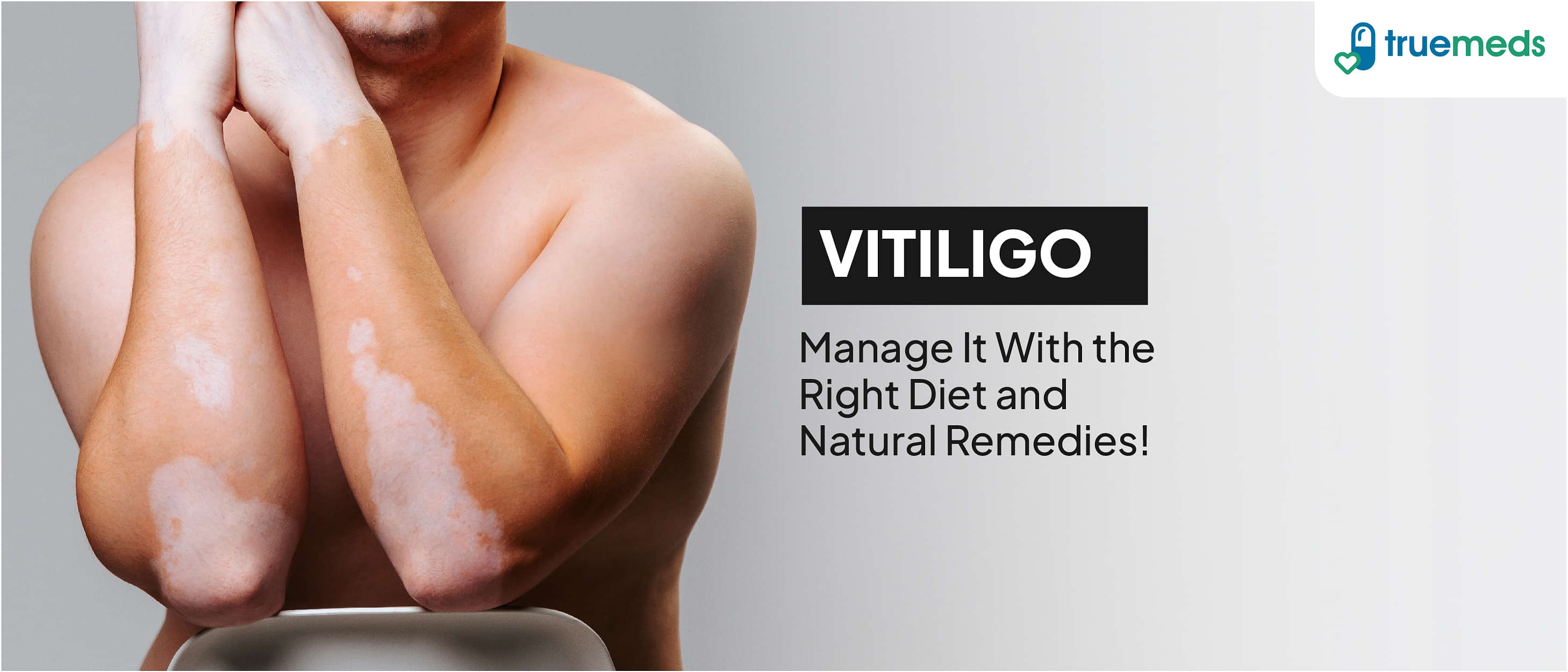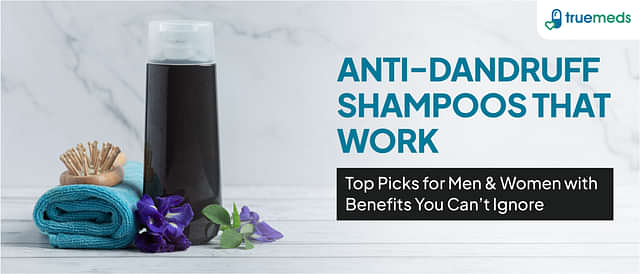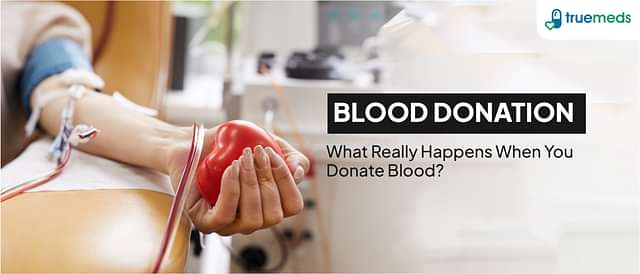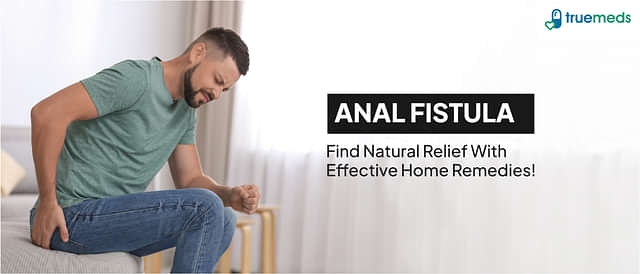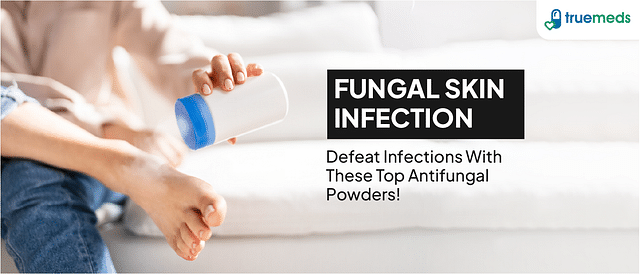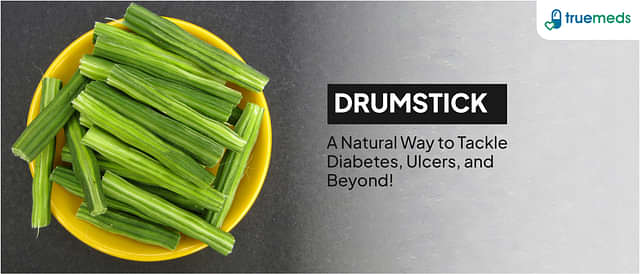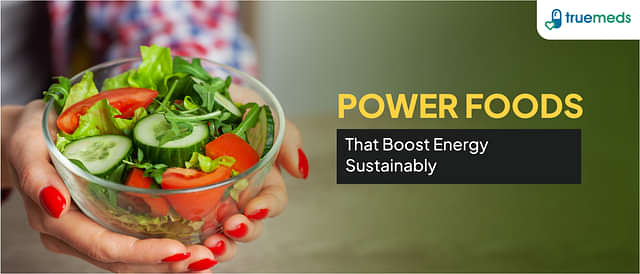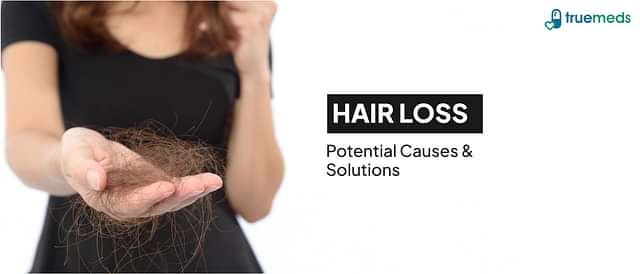Vitiligo Overview: Diet and Natural Remedies for Vitiligo Cure
Last updated on : 26 Dec, 2024
Read time : 11 min
What is Vitiligo?
Vitiligo is a skin disorder in which certain parts of the body lose their pigmentation and become white. The vitiligo diet is something you’ve probably heard a lot about. However, there is no recommended diet for vitiligo that is backed up by scientific evidence. Vitiligo cure with a balanced diet, according to dermatologists, might help enhance the immune system.
Vitiligo is thought to be an autoimmune illness, and having a robust immune system can help prevent depigmentation from spreading. Melanin is responsible for the colour of hair and skin in most cases. When cells that create melanin die or cease working, vitiligo develops. Vitiligo affects people of all skin kinds, however, it is more visible in those who have darker skin. It is not a life-threatening or communicable disorder.
What Are the Symptoms of Vitiligo?
- Skin discolouration develops in patches on the hands, face, and around bodily openings and the genitals.
- Hair on your scalp, eyelashes, eyebrows, and beard that is prematurely whitening or greying.
- The cells that line the interior of your nose and mouth have lost their colour (mucous membranes).
Vitiligo can have a variety of effects depending on the type of vitiligo you have:
- Almost all of the skin’s surfaces-The darkening affects practically all skin surfaces in this type of vitiligo, known as universal vitiligo.
- Many parts of your body-The discoloured patches on related body parts frequently proceed similarly in generalised vitiligo, the most common kind (symmetrically).
- Only one side of your body or a portion of your body-This type of vitiligo, known as segmental vitiligo, appears at a younger age, progresses for a year or two, and then stops.
- Your entire body or just a few parts of it- This type of vitiligo is known as confined (focal) vitiligo.
- The hands and face-Vitiligo that affects only the face and hands and the skin around body openings, such as the eyes, nose and ears, is known as acrofacial vitiligo.
Also Read-Natural Home Remedies for Migraine
Diet for Preventing Vitiligo
Despite the lack of an official vitiligo diet, the best nutritional actions you can take include eating a diet rich in nutrients and drinking enough water. In addition, as with any autoimmune condition, foods high in phytochemicals, beta-carotene, and antioxidants may help enhance your immune system.
Here are some vitiligo-cure foods that people who suffer from vitiligo have found to be beneficial.
- bananas
- apples
- Garbanzo beans (also known as chickpeas or garbanzos)
- Other leafy vegetables
Vitiligo Diet Restrictions
There are no known foods that worsen the vitiligo cure, and there is no advised diet for it either. Anecdotal data, on the other hand, suggests that certain foods, particularly those containing the depigmenting agent’s hydroquinones, cause adverse reactions in certain persons.
how to prevent vitiligo-Some patients with vitiligo have cited these as some of the most problematic foods:
- alcohol
- blueberries
- citrus
- coffee
- curds
- fish
- fruit juice
- gooseberries
- grapes
A quick look at what foods to eat and avoid with vitiligo
A diet rich in certain nutrients, healthy fats, antioxidants and omega-3 fatty acids may be particularly helpful for reducing vitiligo and supporting a healthy immune system, along with other health benefits. People with vitiligo can consider including these foods in their diet.
Beneficial Foods for Vitiligo:
- Fruits: Pomegranate, papaya, guava, and citrus fruits like oranges and lemons.
- Vegetables: Spinach, kale, carrots, tomatoes, and sweet potatoes.
- Whole Grains: Brown rice, quinoa, and millets like ragi and jowar.
- Herbs and Spices: Turmeric, ginger, garlic, and cinnamon, which have anti-inflammatory properties.
- Legumes: Lentils (dal), chickpeas, black beans, and green gram (moong dal).
- Nuts and Seeds: Almonds, walnuts, flaxseeds, chia seeds, and sunflower seeds.
- Healthy Fats: Coconut oil, olive oil, and ghee (in moderation).
- Probiotics: Yoghurt (curd) and fermented foods like idli, dosa, and dhokla.
Foods to Avoid for Vitiligo:
- Gluten: Some people with vitiligo find that gluten exacerbates their symptoms.
- Processed Foods: Avoid processed foods as they are high in artificial additives and preservatives.
- Red Meat: It can trigger inflammation.
- Dairy Products: Avoid dairy products as they might cause skin irritation in some individuals.
- Refined Sugar: Sugar can cause inflammation and impact immune health. Avoid desserts containing refined sugar, such as cookies, candy, and ice cream.
| FOODS TO EAT | FOODS TO AVOID |
| Pomegranate, papaya, guava, and citrus fruits like oranges and lemons | Wheat, Barley, White bread |
| Spinach, kale, carrots, tomatoes, and sweet potatoes | Processed Foods |
| Turmeric, ginger, garlic, and cinnamon (anti-inflammatory properties) | Red Meat |
| Brown rice, quinoa, and millet like ragi and jowar | Dairy Products |
| Almonds, walnuts, flaxseeds, chia seeds, and sunflower seeds | Refined Sugar |
| Lentils (dal), chickpeas, black beans, and green gram (moong dal) | Soda |
| Coconut oil, olive oil, and ghee (in moderation) | Excess Alcohol |
| Curd and fermented foods |
How is Vitiligo Treated?
Vitiligo is a disease that cannot be cured. Medical treatment aims to achieve a homogenous skin complexion by either depigmenting or removing the leftover colour (depigmentation). Camouflage therapy, going vitiligo cure, light therapy, and surgery are among the most common treatments.
- Vitiligo cure by the therapy through camouflage: Using a sunscreen with an SPF of 30 or more. Additionally, the sunscreen should protect against both UVA and UVB rays (UVB and UVA). In order to reduce the contrast between afflicted and normal skin, sunscreens should be used.
- Vitiligo is cure by the therapy for repigmentation: Oral corticosteroids or topical corticosteroids (as a cream put on the skin). Results take 3 months. For long-term use, the doctor will examine the patient for side effects such as skin thinning or striae (stretch marks).
- Therapy with light: For several months, NB-UVB requires two to three treatment sessions per week.
- Ultraviolet excimer laser light has a wavelength similar to narrow-band UVB. This is a better option for people with smaller or more localised lesions, as it is administered to only a few specific places.
- Vitiligo cure by surgery: Allogenic (from the patient) skin grafts: The skin from one portion of the patient is transplanted to another part of the patient. Scarring, infection, or a failure to pigment are all possible consequences. It may also be referred to as mini grafting.
- Micropigmentation: A sort of stitching that is commonly used on the lips of patients with vitiligo.
How to Prevent Vitiligo?
Vitiligo can’t be fully prevented, but you can help manage it by protecting your skin from the sun and avoiding stress. Eating a healthy diet rich in antioxidants may also support your immune system. Here’s how you can prevent Vitiligo:
- Vitiligo can be prevented by following a few simple rules.
- A strong immune system can help avoid it by drinking a lot of water.
- Being a fan of bananas and apples as well as green leafy veggies can help.
- Avoid ingesting alcohol, caffeine, seafood, and red meat in order to avoid white patches.
- Vitamin B and C, amino acids, and folic acid-rich foods can help avoid white patches on the skin.
- When the skin is damaged by cuts, burns, or sunburns, the pigment cells in the skin are killed. The only way to avoid this is to avoid deep skin wood and burns.
Vitiligo Home Remedies
Vitiligo treatments at home are simple and safe to try, with no adverse effects to worry about. These methods, which fall under how to treat vitiligo at home, have been used for many years and have proven beneficial in many situations. If you’re wondering how to cure vitiligo naturally, some of the most common home remedies include:
- One of the most popular home remedies for vitiligo is the use of radish seeds.
- The combination of Ginger and Psoralea is also quite effective in the treatment of this condition. The anti-inflammatory effects of ginger have been documented.
- Turmeric and mustard oil are two powerful vitiligo natural treatments. Inflammation-fighting and germ-killing capabilities are well-known for turmeric. It aids in boosting the body’s defences against bacterial infection.
- Goosefoot is a fantastic home remedy for vitiligo. For best effects, eat this veggie twice daily.
These are some of the most popular and safe home remedies for vitiligo. the home remedies are usually you have to follow the diet.
Vitamins for Vitiligo
Skin pigmentation is thought to be influenced by a number of factors, including vitamins. There are a few examples, such as:
- Vitamins for vitiligo such as folic acid and vitamin B12- Vitamin B12 prevents homocysteine synthesis, a homologue of cysteine. Homocysteine inhibits the enzyme tyrosinase, which produces melanin, and creates free radicals, causing reduced melanin synthesis and melanocyte death.
- Vitamins for vitiligo such as Vitamin A, C, and E- Deficiency in these vitamins can lead to early melanoma destruction, which can be prevented by taking these vitamins as antioxidants.
- Vitamin D- Vitamin D accelerates melanogenesis by boosting tyrosinase activity. Vitamin D insufficiency has been linked to several autoimmune illnesses.
- Beta Carotene is Vitamin for vitiligo- Beta carotene is a powerful antioxidant and vitamin A precursor. It helps preserve normal skin tone and provides photoprotection for lightly pigmented skin.
Conclusion
Vitiligo is often a condition that lasts for life. Although it can’t be cured, there are things you can do, like eating healthy, that might help treat it and keep it from getting worse. You should consult the dermatologist for better advice and get prevented.
If the doctor recommend you some of the prescribed medicine or multivitamins tablets. You may use an online platform like Truemeds. Our online pharmacy, Truemeds provides the highest-quality medications at the lowest prices. We provide all varieties of medications, including branded, over-the-counter, and nutritional supplements, as well as Generic medicines online at an affordable price. With free home delivery, you may save up to 72% when you purchase medications online from Truemeds.
FAQs
Papaya contains antioxidants and beta-carotene, which can help reduce oxidative stress and support skin health. Its nutritional properties may aid in managing vitiligo.
To increase melanin for vitiligo, consume foods rich in antioxidants, vitamins, and minerals like leafy greens, berries, and nuts. Additionally, consider medications, light therapy and consult with a dermatologist for specific treatments.
No, eating fish with milk does not cause or aggravate vitiligo. Vitiligo is an autoimmune condition and is not triggered by dietary combinations.
Vitiligo can be triggered by genetics, autoimmune responses, and environmental factors like sunburn or stress. It’s often a combination of these elements that initiates the condition.
Yes, vitiligo is an autoimmune disease. The immune system mistakenly attacks and destroys the pigment-producing cells in the skin.
Vitiligo is not contagious. It cannot be passed from person to person through physical contact or other means.
Anyone can develop vitiligo, but it is more common in individuals with a family history of the condition or autoimmune diseases. It can occur at any age but often starts before the age of 40.
To address white patches on the face caused by vitiligo, treatments like topical corticosteroids, phototherapy, and depigmentation therapies may help reduce their appearance. If you have vitiligo, start its treatment before it spreads and consult a dermatologist for treatment options.
An immune system attack that destroys melanocytes, the pigment-producing cells in the skin, leads to vitiligo. Genetic factors and autoimmune responses play a significant role in its development.
No, vitiligo is not curable, but treatments can help manage and improve the appearance of the skin.
There is no permanent cure for vitiligo. However, treatments like topical medications like hydrocortisone, clobetasol propionate, and betamethasone valerate may help reduce inflammation. Other topical medicines, named tacrolimus and pimecrolimus , are used to suppress the immune system and are particularly effective for small areas of depigmentation. You may also use Opzelura. This is the first FDA-approved topical treatment specifically for vitiligo, which helps in repigmentation of the skin. Other than creams. light therapy, and skin grafting can help restore skin color and manage the condition effectively.
Disclaimer
Our healthcare experts have carefully reviewed and compiled the information presented here to ensure accuracy and trustworthiness. It is important to note that this information serves as a general overview of the topic and is for informational purposes only. It is not intended to diagnose, prevent, or cure any health problem. This page does not establish a doctor-patient relationship, nor does it replace the advice or consultation of a registered medical practitioner. We recommend seeking guidance from your registered medical practitioner for any questions or concerns regarding your medical condition.
Popular Articles
Recommended Articles
Recent Articles
Top-Selling Medicines:
...View more
Top-Selling OTC:
...View more
Company
About UsHealth ArticleHealth StoriesDiseases & Health ConditionsAll MedicinesAll BrandsNeed HelpFAQSubscribe
Registered Office Address
Grievance Officer
Download Truemeds

Contact Us
Our customer representative team is available 7 days a week from 9 am - 9 pm.
v3.7.10
Our Payment Partners









